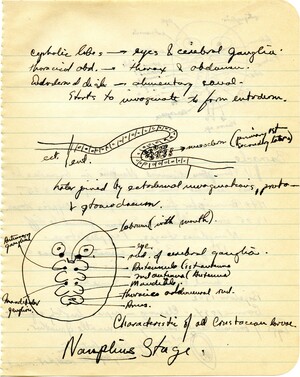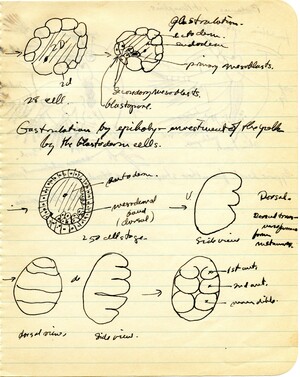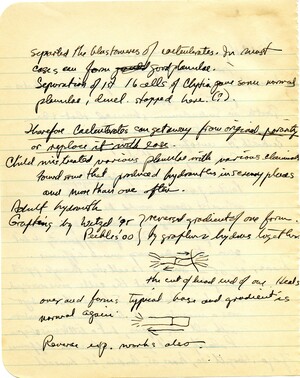MBL Courses
Notes from William Ballard's lecture. Trinkaus begins notes on the "Embryology of the Tunicates" with a list of characteristics, then begins a section on "Embryology of Ascidians" (with a diagram)
Notes from William Ballard's lecture. Trinkaus takes notes on the work of different researchers, like Child, Beckwith, Maas, Conklin, on on regeneration
Notes from Viktor Hamburger's lecture. Trinkaus concludes his notes for this lecture with a diagram of Crepidula
Notes from O. Schotte's lecture. Trinkaus concludes his notes on regeneration with information on a regeneration experiment on the lens, and in Amphibians
Notes from O. Schotte's lecture. Trinkaus begins his notes on "Potencies in Regenerating Tissue" with information on the process of development and begins a list of "Regenerative problems" with two points, "1. Causes of regeneration" and "2. Origin of the material of the blastema"
Notes from O. Schotte's lecture. Trinkaus continues his notes on regeneration with information about the work of Spemann, and relates regeneration to proliferation and differentiation
Notes from Donald Costello's lecture. Trinkaus takes notes on "Astracus--Embryology of." with a series of diagrams from the zygote to several cell stage
Notes from Donald Costello's lecture. Trinkaus draws a series of diagrams on the development of the barnacle embryo
Notes from Donald Costello's lecture. Trinkaus continues his notes on the embryology of crustaceans with information on the derivatives of various parts of the embryo, a diagram on ectodermal invagination, and a diagram on the anatomy of crustacean larvae
Notes from Donald Costello's lecture. Trinkaus continues from the previous two pages with his series of diagrams on the development of the barnacle embryo, including information on the cell lineage
Notes from William Ballard's lecture. Trinkaus continues notes on Coelenterates and regneration
Notes from Viktor Hamburger's lecture. Trinkaus begins his notes on "Experimental Embryology of the Annelida & Mollusca" with information on the cell lineage studies of E.B. Wilson












